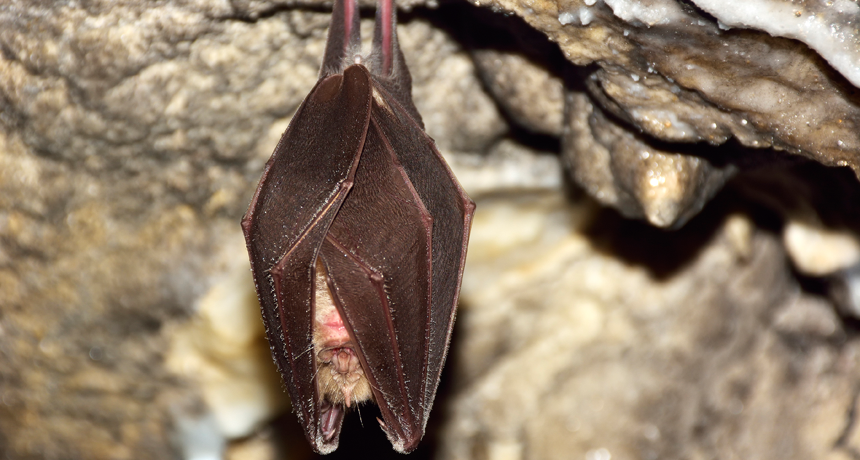Explainer: How brief can hibernation be?
For a half-century, scientists have debated whether animals can hibernate for as little as a day

This bat is hibernating. Is that just a more extreme version of going torpid every day? Scientists disagree.
AttilaBarsan/istockphoto
When times get tough and food is scarce, some mammals save energy through torpor. It’s a process whereby they drop their body temperatures and dramatically slow body processes. It may last a short while — even as little as a day. Other mammals descend into virtually nonstop torpor for months. They literally hibernate the hard times away. So is hibernation just a prolonged form of daily torpor? Or are the two entirely different? The answer, it turns out, will depend on whom you ask.
Some scientists argue that hibernation is an extra-deep, super-long version of daily torpor, which is itself a deeper, longer version of sleep. Others reject that. Daily torpor and hibernation are completely different, they maintain — and sleep’s got no place in either.
Sandy Martin studies hibernation at the University of Colorado School of Medicine in Aurora. And “the way we’ve described it,” she says, is that the underpinnings of deep sleep, of torpor and of hibernation are one and the same.
In slow-wave sleep — the deepest form — a mammal’s body temperature drops a bit. So does its metabolism, the set of chemical activities in its cells that keep this animal alive. When a mammal goes torpid, its body temperature and metabolism drop a lot. And when an animal hibernates, temperature and metabolism plummet far more. So the difference between sleep, torpor and hibernation is only a matter of degree, Martin argues.
“We have to think about hibernation [and torpor] as a continuum rather than discrete things,” agrees Frank van Breukelen. He’s a biologist at the University of Nevada in Las Vegas.
To scientists like them, torpor and hibernation all start with metabolism. As animals slow their metabolism (and no one knows how that occurs), body temperatures will drop. Slowing metabolism a little and for just a brief period produces slow-wave sleep. Slow it more and longer and it becomes torpor. Slow it dramatically for prolonged periods and you get hibernation.
The idea of such a hibernation continuum places all mammals on one continuous line. At one end are animals that never go torpid. People fit into this group. At the other end are bears, bats and other animals that may hibernate for months straight.
Riding the temperature cycle
Other scientists reject this idea of a continuous line. Among them is Fritz Geiser. He’s a zoologist, someone who studies animals, at the University of New England in Armidale, Australia. Animals that go into torpor for just a day are nothing like animals that hibernate for months, he charges. The two are distinct,” he says, “and people who don’t think so don’t get it right.”
White-footed mice, shrews and some birds are examples of species that go into torpor daily. They’re sometimes called daily heterotherms. That term means their body temperature varies widely throughout the day. Their body functions slow during the daily low in body temperature. But this state doesn’t last more than a few hours. “These are species which cannot do multi-day bouts” of continuous torpor, says Geiser. Doing that would kill them.
While their metabolisms slow, they never dip as low as those of hibernators. True hibernators might drop their metabolism by 94 percent or more. In contrast, Geiser notes, animals that experience daily torpor drop theirs by only some 65 percent. “It’s a huge difference,” he says. “They just do things very differently.”
That difference also extends to how their torpor works, Geiser observes. Daily heterotherms use their daily body rhythms to control their torpor. When they go torpid, they just turn off their temperature regulation. This lets them save energy. As they cool, their metabolism naturally slows.
Hibernators, on the other hand, actively work to drop their metabolism in addition to cooling down. In hibernators, the changes include “switching off enzymes,” Geiser explains, which means their metabolism will decrease much more than a daily heterotherm’s. Daily heterotherms just let temperature changes do all of the work.
Why does it matter?
Torpor versus hibernation? Each side in this debate has its defenders. They publish papers arguing for and against each other’s points. They meet up to debate at scientific meetings. In the end, what’s the point?
“You could say, okay, it doesn’t really matter,” Geiser says. “But that’s what science is about — you try to categorize things.”
It’s not just about putting behaviors into different buckets, though. It’s about learning exactly what torpor and hibernation are, how they work and why animals evolved to use them the way they do. Scientists need to answer these questions to fully understand how an animal has adapted to succeed in its environment.
And people may benefit from that knowledge if there’s any hope of using torpor or hibernation to treat human disease — or to visit Mars.
The debate between the two groups of scientists has been going on for decades, says van Breukelen. “You put five biologists in a room and you’ll get eight different ideas,” he jokes. “We have a hard time coming to a consensus,” he explains. “I think it’s because of the incredible spectrum of hibernators.”
The debate may end only when scientists crack the mystery of what exactly makes animals go torpid or hibernate. If the same mechanism controls both, the continuum side may win. But if daily torpor is unique, the other side may take the day. In the meantime, there are many ways for a mammal to chill out — and trying to understand what they have in common can make scientists lose their cool.







